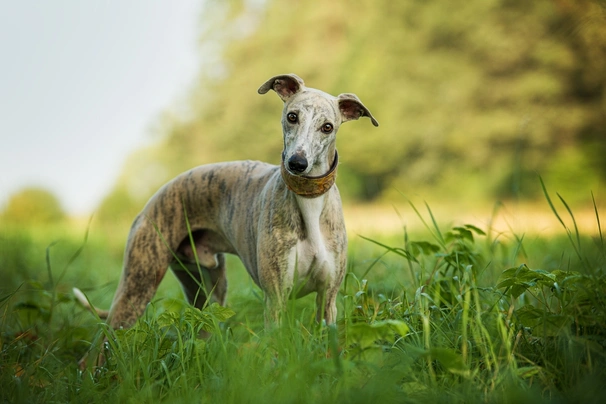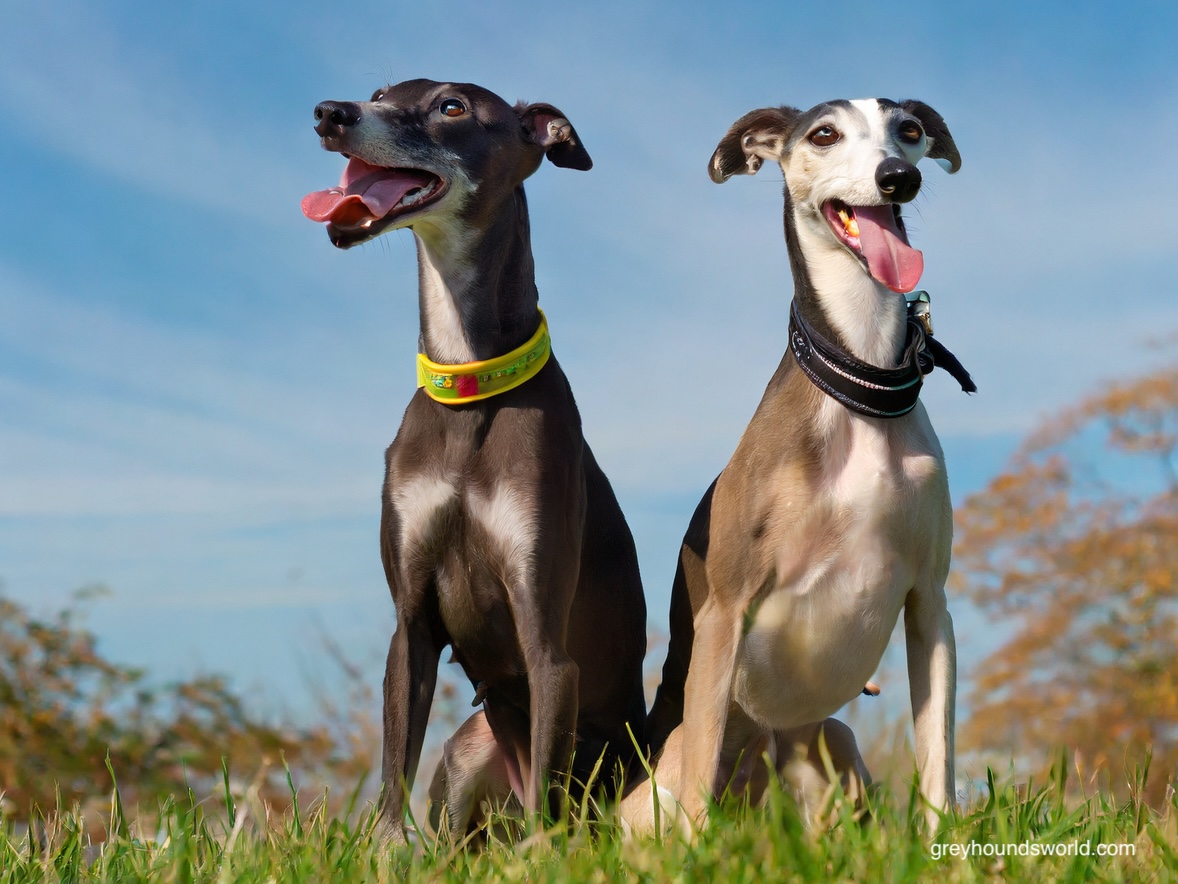The Whippet is a sighthound breed originating in England. Known for their sleek, athletic build, Whippet’s have a fascinating history and make wonderful companions. Let’s delve into the various aspects of the Whippet breed.
Overview and history
Whippets developed in the 18th century in England, more specifically in Lancashire and Yorkshire, as a cross between greyhounds and terriers. Their main purpose was to hunt small animals such as rabbits. But because of their speed and agility, they also became very desirable for racing. Over time, Whippets gained popularity as beloved pets due to their gentle nature and adaptability.
Appearance and Physical Characteristics
The Whippet is like the Olympic athlete of dogs, a true model of leanness, muscle and agility. Imagine Usain Bolt, but in canine form. This athletic dog is the perfect result of a competition between strength and elegance, as if he were wearing a suit while running a marathon! With his sculpted physique, he’s the ideal friend for work and fast fun at the park. The fitness hero of the canine world, ready to conquer tracks and hearts!
Size and Proportions
Whippets are intermediate in size between Italian Greyhounds and Greyhounds. The male stands 19 to 22 inches at the shoulder; females stand 18 to 21 inches. Males weigh an average of 34 pounds and females 29 pounds.
Coat and Color Variations
Their short, fine, dense coat comes in a wide variety of colors and patterns, including brindle, black, fawn, blue, and white, to name a few. Several colors can be combined, making each Whippet’s coat unique.
Distinguishing Features
Whippets are medium-sized dogs with a sleek, muscular body. They have a deep chest, a slim waist and long, slender legs. Its tail is short-haired, long and pointed. When moving, it is lifted and forms a graceful curve. Their life expectancy is between 12 and 15 years.

Temperament and sensitivity
The Whippet is known for its friendly and affectionate nature. They are gentle, loyal and excellent companions for families of all sizes. Although generally calm and polite indoors, they have bursts of energy and love to participate in short, high-intensity exercise sessions.
Neighborhood Fellowship
Despite its sleek appearance, the Whippet is like the cool neighborhood friend who’s always ready to hang out. His nobility translates into an easygoing companion, always willing to share the couch and enjoy the good vibes of life.
Fast love and unbreakable loyalty
Beneath this athletic and fast exterior, the Whippet is a master of unconditional love. His loyalty is as unwavering as his speed. Not only does this dog run with speed, it loves with the same intensity. Whether in the park or on the couch, the Whippet will be a faithful companion, ready to run with you through life and provide quick, loving hugs and kisses when you need them most.
Interaction with Children and Other Pets
- Because of their playful and active nature, Whippets are ideal companions for children. The question to ask is whether the children in the house understand that they are living creatures and not toys. If they do, they will soon get on well and have a lot of fun. However, as with any breed of dog, it is important to supervise interactions and above all to teach children to be respectful of their canine companions.
- The Whippet is like the good neighbor that gets along with everyone in the house, whether it’s other dogs or any other creature with feathers or fur. With its calm and friendly demeanor, this dog makes friends easily. He may have bursts of playful energy, but his mantra is peace and companionship. On the patio or on the couch, the Whippet is the peacemaker, creating a harmonious coexistence with other furry family members. However, it is important to keep in mind that Whippets have a strong prey drive, so proper socialization and training from an early age is essential to prevent chasing behavior.
Training and exercise needs
Whippets are easy to train because of their intelligence and good nature. The best way to do this is with patience, cuddles and positive reinforcement.
Daily Exercise Needs
Although you might think that Whippets need intense training sessions, nothing could be further from the truth! Adult Whippets are experts at relaxing and mastering the art of the couch.
To keep them happy, try this:
- Short walks with moments of freedom are key to developing their independence and maintaining their own pace.
- Also, keep them entertained with ball games, stuffed animals, or the classic search for sticks.
- And when the weather isn’t cooperating, give your Whippet a fashionable look with a coat or raincoat.
Stress-free exercise, fun and style, that’s the Whippet vibe!
Mental Stimulation and Training
Whippets are intelligent dogs that respond well to positive reinforcement training methods. They are eager to please their humans and can quickly learn commands and tricks. Also keep in mind that Whippets are sensitive and can become nervous if harsh training methods are used.
Health and Care Guidelines
Being aware of your Whippet’s potential health problems and learning basic care is like having the magic formula for a very happy and relaxed dog life. From regular checkups to favorite treats, it’s the perfect guide to keeping your furry friend in pure joy and tail-wagging mode!
Common Health Issues
While Whippets generally enjoy good health, they might have a few conditions. Recognizing these nuances and providing them with some extra love and care can contribute to ensuring they smoothly navigate the journey of life.
- Dermatologic problems: Some Whippets may be prone to skin allergies and dermatitis. For this reason, it is best to only bathe them when they are really dirty and to keep their coat as dry as possible.
- Whippets can also suffer from hereditary eye problems, such as cataracts and blindness due to progressive retinal atrophy. Veterinary check-ups will help you to detect these problems early.
- They are chemically sensitive to certain compounds and medical treatments, such as anesthesia, probably because of their low percentage of body fat.
- Von Willebrand disease: This rare disorder affects the clotting process. It can manifest itself through symptoms such as profuse or spontaneous gum bleeding, prolonged bleeding during events such as heat, whelping, or surgery. Although there is no cure, it can be well managed with treatment under the guidance of a vet.
Proper Grooming and Maintenance
Luckily, the Whippet does not require much grooming. All the energy you save here can be spent on walks in the park or inventing games to stimulate their curious minds.
- Grooming: You can brush your Whippet’s coat with a soft brush, especially during the moulting season. Make sure his skin is healthy and bathe him when he is dirty enough to lay with you on the couch. Make sure he is dry after each bath.
- Dental Care: Proper dental hygiene is essential to prevent further damage. If you have adopted an adult Whippet, the vet can perform a professional cleaning during your visit to remove any tartar buildup. After that, you will need to maintain his dental hygiene with regular cleanings at home. Always use a soft brush and special dog toothpaste.
- Nail Care: Your Whippet’s long nails do not allow it to walk well and can cause gait problems if not corrected. If you hear the nails clicking on the floor, they are too long. You can set up an at-home nail service once, or take it in to have it done by a professional.
- Ear Care: Check your dog’s ears, but only the outside. If you think they need to be cleaned, do so by moistening a cotton ball with a special cleaner. Do not clean with water or insert anything into your Whippet’s ear. If you notice redness in any part of his ear, take him to the vet as it could be an infection.
Is the Whippet your ideal mate?
A unique combination of speed and gentleness, the Whippet is known for its relaxed and friendly temperament. As a companion, he is loyal, adaptable, and has a casual elegance that makes him ideal for active play as well as cuddling on the couch. Perfect for a variety of homes, their generally robust health benefits from moderate care and constant love. With his easy charm and relaxed disposition, the Whippet is not only a canine companion, but a valued and loving member of the family.
| Pros | Cons |
|---|---|
| Affectionate with children, other pets, and guests. | High prey drive. |
| Minimal coat shedding and drooling. | May have separation anxiety. |
| Active, but less active than other sighthounds. | Does not tolerate cold weather. |
| Low-maintenance coat. | This is not a guard dog, so don’t count on it. |
| Easy to train. | May chew (break) things if left alone too long. |
In conclusion, the Whippet is a beautiful and versatile breed. With its affectionate temperament and impressive athletic ability, it is a great choice for active individuals or families looking for a loyal and elegant companion.
Frequently Asked Questions about Whippets
Are Whippet dogs dangerous?
Not at all. Whippets are friendly, non-aggressive dogs. They may be shy at first, but once they gain confidence, they spread love and smiles everywhere.
Are Whippet puppies easy to train?
Whippets are intelligent dogs, but with a touch of independence. This makes them sometimes difficult to train. If you start with positive reward-based training from puppy age, you will have a super dog in no time.
Can Whippets live with cats?
Although Whippets have a high prey drive, this does not mean that they will get along poorly with cats. It is important to socialize early and to monitor the behavior of both animals.
Can Whippet be left alone?
Not recommended. Whippets are companionable and very sensitive dogs. Therefore, for their health, they should not be left alone for long periods of time as they may suffer from hyperactivity and separation anxiety.
Are Whippets good apartment dogs?
The Whippet's size and temperament make it an excellent dog for apartments and small homes. Their coat shed very little and is odorless, making them an ideal and clean companion.
How fast are Whippets?
Whippets are the fastest of the medium-sized dogs, reaching 56 km per hour (35 miles per hour). Even over short distances they are faster than the Greyhound (and all other dogs in the world), thanks to their great acceleration capacity.
